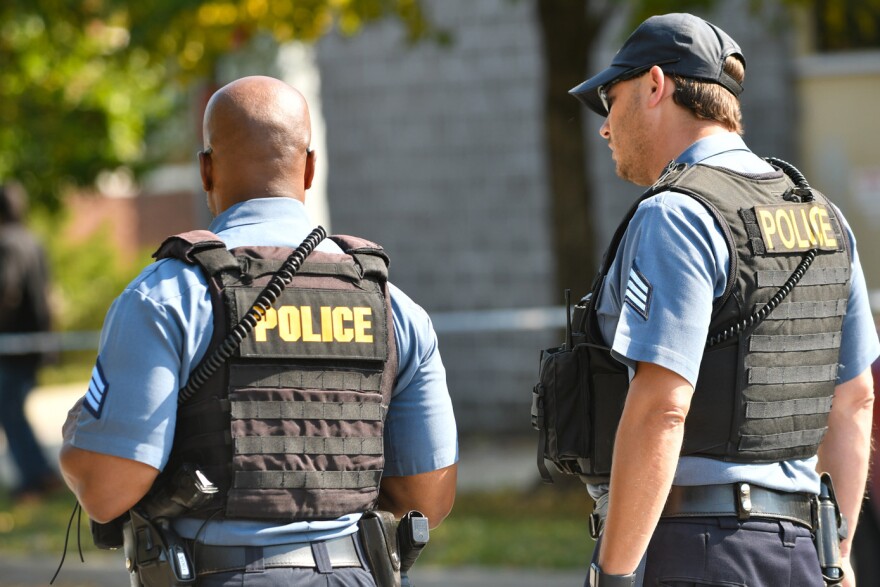An audio surveillance technology the Kansas City Police Department uses to detect the location of gunshots has failed to reduce violent crime, a new study says.
An academic research project funded by the National Institute of Justice found that the use of ShotSpotter, a gunshot detection technology, resulted in a few benefits but didn’t meet its original goal of increased prosecutions of gun-related crime.
ShotSpotter is an “acoustic surveillance technology,” according to its manufacturer, with audio sensors placed in strategic areas — typically on rooftops or utility poles — that detect gunfire, locate the area, then send the real-time data to police via 911, officers’ desktops, smart phones or smart watches.
Kansas City has used ShotSpotter since 2012, a decade when the city’s homicide rate repeatedly set records.
Still, the Kansas City Board of Police Commissioners is sticking with ShotSpotter — for now. In September, the board approved nearly $200,000 for a one-year renewal of a contract with SoundThinking, Inc., the maker of the ShotSpotter system, which will run from October 2023 through September 2024.
But during a meeting in October, some commissioners waffled over continuing to use ShotSpotter. Commissioner Dawn Cramer suggested dropping the program so they could use the money to increase officers’ salaries.
The study, lead by Dr. Eric L. Piza, a professor in the School of Criminology and Criminal Justice at Northeastern University, looked back to the start of the program in 2012 and analyzed three years of data.
“Unfortunately, we didn’t find a terrible amount of evidence that this actually translated to significant crime reduction,” Piza said during the board’s October 31 meeting.
Shooting crimes that happened in the area covered by ShotSpotter also didn't have a higher clearance rate, Piza said.
"So essentially, if a crime occurred within the ShotSpotter area, it was not any more likely to be solved than crimes occurring (in other areas)," he said.
However, the researchers found some positives, he said, including that officers responded faster to ShotSpotter calls than regular calls for service, ShotSpotter offered a more accurate geographic location than just an address, and officers responding to ShotSpotter calls tended to work a crime scene longer to gather evidence.
Police support the use of ShotSpotter

Kansas City Police defend the use of ShotSpotter, saying there are multiple factors involved in violent crime, with no one cause or solution. ShotSpotter is part of KCPD's violent crime response and reduction plan, said Sgt. Jake Becchina, a KCPD spokesman.
"The effects of ShotSpotter have largely always been best described in an anecdotal way with stories how the program helped officers find an exact location, or helped detectives gather precise investigative data to aid in their case that involved gunfire," Becchina said.
Becchina analyzed 911 calls and found that just 30% of outdoor gunfire was being reported with a call to 911, but in the ShotSpotter area, police were notified nearly 100% of the time.
"That’s 70% more gunfire incidents that we are made aware of than we otherwise might not have," Becchina said. "That’s 70% more investigative leads, 70% more contacts with citizens to gather information about the problem of gun violence in their area."
ShotSpotter officials point to the benefits found in Piza's research, emphasizing that the program helps with faster and more precise responses to shootings, increased collection of ballistic evidence and more illegal firearms taken off the streets.
Piza has said that ShotSpotter detected gunshots about 1.5 minutes before calls came into 911, giving police a head start on responding to the scene, identifying victims and transporting victims to the hospital.
"While no tool can single-handedly reduce violent crime, the experience of our customers illustrates how important ShotSpotter is to a comprehensive strategy to address gun crime," a ShotSpotter spokesperson said.
ShotSpotter is divisive in Kansas City and beyond

ShotSpotter has been controversial in several cities, with criticism that it had no significant impact on homicides or arrests, that it tends to focus solely on minority neighborhoods and that it increases the likelihood of dangerous interactions between citizens and police.
Atlanta; San Antonio; Portland, Oregon; and Fall River, Massachusetts have wrestled with the use of ShotSpotter Cities that have recently decided to keep the technology, despite some concerns, include Seattle; Durham, North Carolina — and Chicago, even though that city's new mayor pledged to end the program.
Kansas City implemented ShotSpotter in 2012 through the Kansas City Area Transportation Authority, which used a federal grant to improve safety for public transportation. The ShotSpotter sensors were placed in the 3.5 square miles where the buses travel, mostly on the east side of Troost Avenue.
KCPD took over funding for the program in 2017 and has spent a total of $1.3 million on it since then.
U.S. Rep. Emanuel Cleaver, a Kansas City Democrat, heralded the arrival of ShotSpotter in 2012 as a proactive policing strategy aimed at ridding the city of gun crime.
“Once implemented, KCPD will also be able to gather more detailed gunfire incident information and forensic evidence for investigations and analysis, resulting in increased prosecutions for gun-related crime, and the data will enhance crime analysis and predictive policing capabilities, leading to improved public safety and security,” read a press release from Cleaver’s office at the time.





